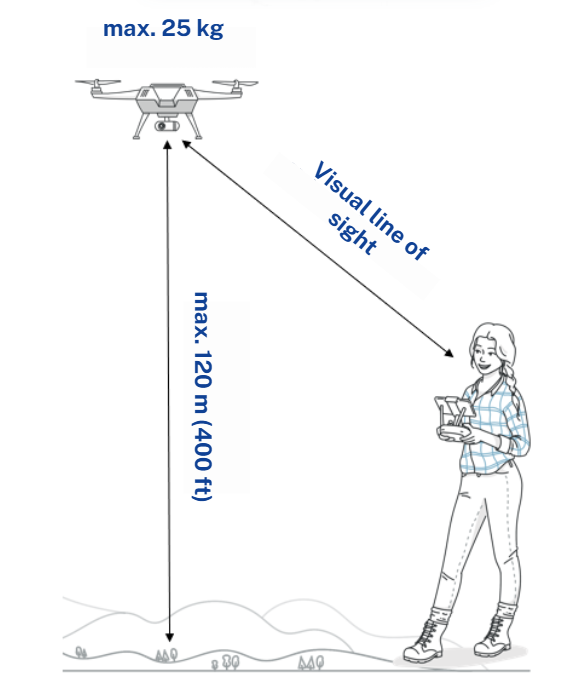For most hobby pilots and commercial operations within visual line of sight (VLOS), the "open" category is the simplest solution. As long as the operational limits of the "open" category (e.g., weight, flight altitude) are adhered to, no operational approval from Austro Control is required before the flight.
Key rules to follow:
- Operator Registration: The drone operator must be registered. More information can be found hier.
- Mandatory Insurance: All drones in operation must have adequate insurance coverage. According to aviation law, the minimum coverage is 750,000 Special Drawing Rights (SDR).
- Competency Certificate: The drone pilot must hold an appropriate competency certificate (see below for details).
- Visual Line of Sight (VLOS): The drone may only be flown within direct visual contactthis means continuous, unaided visibility of the drone without technical assistance.
- Altitude Limit: Maximum flight altitude is 120 meters (400 feet) above ground level.
- No Transport of Dangerous Goods or Dropping of Objects: The drone must not be used to transport hazardous materials or drop objects.
- Important: In certain areas, additional approvals may be required. Please check here for further details.
- Takeoff & Landing Permissions: According to § 2 of the Austrian Aviation Act, airspace usage for drone flights is generally permitted. However, this regulation only applies to overflight. For takeoff and landing, drone operators must obtain permission from the property owner.
Frequently Asked Questions
My drone does not have a class identification label (CIL) of the specified C0 to C4 classes. Can I still operate it under the European regulation, or do I need prior authorisation from Austro Control?
If the drone is operated within the Open category, no authorisation from Austro Control is required. Since 1 January 2024, drones without a CIL can still be used in the Open category, provided specific weight limits are not exceeded (e.g., up to 249 g for operations in subcategory A1) and the operational requirements of subcategory A1 are met. The drone operator must register online and ensure that all remote pilots have the required competency. All other drones without a class identification label may only be operated in subcategory A3 from 1 January 2024.
Can I continue to fly my old drone without a CIL in the Open category?
Yes, but certain requirements must be observed. The transitional period for drones that are not CE class-compliant, including self-built drones, ended on 1 January 2024. Drones weighing up to 249 g may continue to be operated in subcategory A1 without a CIL. All other drones without a CIL may still be flown in subcategory A3.
My drone weighs less than 250 g but has a camera. Do I need to register and take the online test?
Yes, registration is mandatory. However, you are not required to take the online test.
My drone weighs more than 250 g but less than 900 g at take-off. Do I need to complete the online test or is registration sufficient?
Yes. You are required to complete an online training course and pass an online test. Registration is also mandatory. Don’t forget to obtain valid insurance coverage and visibly display your registration number on the drone.
What do manufacturers need to consider when placing UAS with a class identification label (CIL) on the market?
Who is responsible for ensuring continued compliance of UAS during operation?
Responsibility lies with the UAS operators themselves. They must ensure that the drone remains compliant with the applicable regulations and that no unauthorised modifications are made.
Responsibility lies with the UAS operators themselves. They must ensure that the drone remains compliant with the applicable regulations and that no unauthorised modifications are made.
Who is responsible for ensuring continued compliance of UAS during operation?
Responsibility lies with the UAS operators themselves. They must ensure that the drone remains compliant with the applicable regulations and that no unauthorised modifications are made.
Are operators allowed to modify their UAS?
Operators must not modify UAS of class C0, C1, C2, C3, or C4 in any way that violates product requirements, unless the modification is specifically foreseen and documented by the manufacturer.
Which types of modifications are explicitly prohibited?
Any modification that affects the weight, centre of gravity, or performance of the UAS and causes it to operate outside the manufacturer’s specifications is prohibited.
Is replacing parts during maintenance considered a modification?
No. Replacing a component with an identical original part or a manufacturer-approved part for maintenance purposes is not considered a modification.
Under which conditions can a payload be attached to a UAS?
Attaching a payload is permitted if it complies with the manufacturer’s instructions and the drone is designed for such use.
What happens if a payload or modification does not meet the requirements?
In such cases, the class identification label becomes invalid. The modified UAS may then only be operated within the Specific category.
Are there exceptions for UAS with a C4 class identification label?
Yes. Modifications to C4-class UAS are permitted. These drones can be considered “privately built” and may continue to be operated in subcategory A3 of the Open category.


